 |
Book Reviews |
Last updated 12 October 2002

| index |
64 Great Chess Games
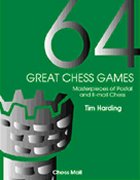
by Tim Harding
Introduction
After his multimedia exploits with the "Total Marshall" (see Magazine 77), the prolific CC-SIM Tim Harding has now produced an anthology of 64 high-quality games (subtitled "Masterpieces of Postal and Email Chess") which will delight, in particular, the CC fraternity, but should also be instructive reading for every OTB player.
This time the medium is simply paperback, but you get a chunky 304 pages for your £15.99, contrasting favourably with some of the slimline offerings available in the current chess book market. However, the real value of this publication lies in the superb balance achieved between game selection, expert analysis and lucidity of annotation. The resulting harmony shows off the particular fascinations and artistry of the correspondence game in fine relief, and totally dispels the uninformed criticism which, inter alia, often portrays CC players as no-mark anoraks, exchanging Fritz moves with each other!
Contents
The starting point is game selection. Harding has sensibly gone for variety over time, rather than tried to subjectively rank the "64 best CC games ever". The timescale ranges from 19th to 21st century, and the players include top OTB grandmasters such as Andersson, Barcza, Chigorin, Kasparov, Keres, Maroczy, Penrose, Simagin, Steinitz and Vidmar, as well as the great correspondence chess specialists like Anton, Berliner, Elwert, Palciauskas, Purdy, Rause, Rittner, Sloth, Timmerman, Zagarovsky and Umansky, and high quality games by talented amateurs too.
The spread is genuinely global; nobody gets more than three games; the opening variations and styles of play are well differentiated; and every game lasts at least 25 moves.
Review
Each game has been comprehensively analysed, beginning with the circumstances under which it was played, examining the main strategic ideas involved and looking closely at the principal variations possible. The annotations provided by the players are freely quoted, but Harding (and his editor CC-SIM Jonathan Tait) are not content with slavish reproduction of supplied material - commentary is often challenged and/or lines extended in order to show (warts and all) just what might have happened as well as to apply underlying rigour to what did.
Best of all however (to my mind), is the presentation format, and in particular, the way in which a context is always provided to aid understanding. This ranges from the player biopics, through the background notes to each game, to the interplay of text and move notation in the notes. Nowhere is the reader abandoned to endless computer analysis; there is always a clear explanation of what is going on before any detailed analysis is given. This makes for a very instructive text, suitable for most grades of player.
It's really nice to see a dedicated CC production amongst the welter of chess literature, and this offering deserves seriously high commendation not only for raising the profile of CC, but by raising the bar generally for chess publishing standards. It's an ideal reference volume, and will repay your investment over many years - perhaps some suggestive noises about Christmas presents are now in order!
"64 Great Chess Games" is produced by Chess Mail, and retails at £15.99 (25 Euros). Orders placed from the UK or Ireland before 31 October will avoid p&p. Tim will gladly receive your business at 26 Coolamber Park, Dublin 16, Ireland, or you can order online at the Chess Mail website.
Sample Game
Tim has kindly consented to me reproducing one of the 64 games in full here, to demonstrate the presentation quality. I've chosen one with a Scottish flavour, featuring Colin McNab, albeit on the losing end to Arild Haugen of Norway (there are no Scottish wins in the book, which I'm assured will be remedied in any sequel! Perhaps one of our roles in world CC is to lose instructively...) SCCA readers should also recognise the victor - he has been giving George Pyrich a hard time of it in the current friendly international, and one of their games appears in the games column of this magazine.
| 6th European Championship Prelims, 2000 White: Arild Haugen (2571) Black: Colin McNab (2487) Modern Defence [B06] [Notes by Tim Harding and Arild Haugen] | |
| The Players: Haugen is an ICCF SIM; McNab is both a FIDE GM and ICCF SIM; he has been a member of Scottish postal and OTB teams for many years, including Scotland's bronze medal-winning team in CC Olympiad XI. | |
| About this game: McNab is a positional player who rarely varies his solid opening repertoire. Haugen tackled the challenge of winkling him out of his shell with great creativity and created a position with enormous problems for both players. Black survived the first wave of the attack, but the second washed him away. | |
| 1.e4 | g6 |
| 2.d4 | d6 |
| 3.Nc3 | c6 |
| Haugen's research showed that it wouldn't be possible to surprise McNab. The Scotsman has faced, for example, 4.a4, 4.Be3, 4.Bc4, 4.Nf3, 4.g3, and 4.h4 in this position. | |
| 4.f4 | d5 |
| 5.Nf3 | |
| Although McNab has been playing 1.e4 g6 2.d4 d6 3.Nc3 c6 since 1992, his book "The Ultimate Pirc" (with GM John Nunn) says almost nothing about this line except the explanation that after 4.f4 d5 5.e5 h5, "the benefit to Black from not having played Bg7 slightly outweighs the loss of time with his d-pawn". Clearly McNab wanted to keep his own secrets! | |
| 5... | dxe4 |
| 6.Nxe4 | Bg7 |
| 7.Bc4 | Nh6 |
| 8.c3 | |
| 8.h3 Nf5 9.c3 0-0 10.Bb3 Nd7 11.g4 Nd6 12.Nf2 c5 13.Be3 b6 14.Bd5 Bb7 15.Bxb7 Nxb7 16.Qe2 cxd4 17.Bxd4 Bxd4 18.Nxd4 e5 19.fxe5 Re8 and Black was ok in N.McDonald-McNab, Hastings II, 1993-94 (0-1, 29). | |
| 8... | 0-0 |
| 9.Ne5 | Nd7 |
| 10.h4!? | |
| At last White is able to go his own way. Haugen thought this direct approach with the h-pawn was justified in view of the three tempi expended by Black on the maneouvre d7-d6-d5xe4. So he varied from 10.0-0 Nf6 11.Nf2 Nf5 12.Qf3 Nd6 13.Bb3 a5 (A.Zanetti-McNab, CNEC-15, corr, 1993); Black seems ok there, although White eventually won. Instead, 11.Qe2 Nxe4 12.Qxe4 Qd6 13.f5!? Nxf5 14.g4 Bxe5 15.dxe5 Qc5+ 16.Rf2 Ng7 17.b4 Qb6 18.Be3 Qc7 19.Bh6 Be6 20.Bxe6 fxe6 21.Raf1 Rxf2 22.Rxf2 Rf8 23.Rxf8+ Kxf8 24.Qd4 b6 25.a4 c5 led to a draw in a 1992 OTB game Shirov-McNab. | |
| 10... | Nf6 |
| Haugen reckoned that 10... Nxe5 11.fxe5 would give him a winning attack after 11... Bg4 (or 11... Bf5 12.Nf2) 12.Qd3 Qd7 13.h5 gxh5 14.Ng3. | |
| 11.Ng5! | Nd5 |
| 11... e6 would negate Black's strategy, leaving his c8B a very limited future after 12.Qc2! | |
| 12.h5 | |
| Now the real fight begins. The Viking plans to sacrifice his "wild horses"! Black has little choice but to accept what is thrown at him and hope to survive. | |
| 12... | f6 |
| Now 13.hxg6 fxe5 14.gxh7+ Kh8 15.fxe5 is possible, with three pawns for the N, but White had a more dramatic idea in mind. | |
| 13.Nxh7!! | |
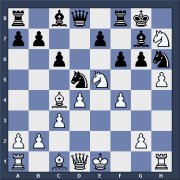 | |
| 13... | Kxh7 |
| 14.Nf7!! | |
| This is the point.14.hxg6+? might seem obvious but, at the end of the sequence 14... Kg8 15.Rxh6 Bxh6 16.Qh5 Kg7 17.f5 Rh8 18.Bxh6+ Rxh6 19.Qxh6+ Kxh6 20.Nf7+ Kg7 21.Nxd8 Bxf5, Black probably has some advantage. | |
| 14... | Rxf7 |
| After 14... Nxf7 15.hxg6+ Kg8 16.Qh5 White's attack is very strong as Haugen shows: (a) 16... Nh6 17.f5 Qd7 18.g4 e6 19.Bxh6 Bxh6 (If 19... exf5 20.Bxg7 Re8+ 21.Kf2 Qxg7 22.gxf5 b5 23.Bxd5+ cxd5 24.Qf3 followed by invasion on d5 or h7) 20.Qxh6 Qg7 21.Qxg7+ Kxg7 22.Rh7+. Now Haugen just says White wins; presumably he means 22... Kg8 23.Kd2 exf5 24.Re1 (not 24.Rah1 fxg4 25.g7 Rf7) 24... Rd8 (24... fxg4 25.g7 Rf7 26.Re8+) 25.Reh1 (25.Ree7 only draws) 25... Be6 26.Bd3 Kf8 27.Rxb7. (b) 16... Ng5 17.fxg5 Re8 18.Bf4! Kf8 (to get out of the pin on the N, because if 18... b5 19.Bxd5+ Qxd5 20.0-0 Kf8 21.Be5 followed by an explosion on f6, or 18... Bf5 19.0-0+-) | |
| 19.Be5 Be6 (19... Ne3 20.Bf7 fxe5 21.Qh7 and mate on g8) and now White has time to bring up the reserves: 20.0-0 Bg8 21.Rae1+-.So, instead of accepting a whole piece, McNab tries to calm the attack by taking two minor pieces for the rook. Positions with unbalanced material and exposed kings are difficult to calculate exhaustively. | |
| 15.hxg6+ | Kg8 |
| 15... Kxg6 also looked interesting (for White) said Haugen, eg. 16.Qh5+ Kh7 17.Qxf7 Qf8 18.Bxd5 cxd5 19.Qxd5 Qe8 20.f5. Now, after 20... Qc6 (only move) White plays for a bind with 21.Qxc6 (not 21.Rxh6+ Bxh6 22.Qf7+ Bg7 as White can't get the other R to the b-file) 21... bxc6 22.Bxh6 (22.g4 e6) 22... Bxh6 23.Rh5 Kg7 24.Kf2 Bd7 25.Re1! Re8 and now 26.c4 or 26.a4 or 26.g4.Whether Black sits tight or plays for ...e6 and a R-exchange, White will obtain at least one passed pawn on the queenside and the defence will be arduous. | |
| 16.f5 | |
| More fuel on the fire: the dark-squared B now enters the game. | |
| 16... | Nxf5 |
| 17.gxf7+ | Kf8 |
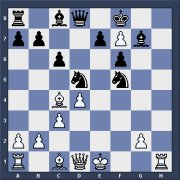 | |
| The Black K hopes to hide behind the pawn and capture it later. 17... Kxf7 might have been possible, as after 18.Qh5+ Kg8 19.Qh7+ Kf7 20.Bd3 e6 21.g4 Nfe7 22.Bd2 Haugen gives 22... f5! (better than 22... Qg8 23.Qh5+ Kf8 24.c4 Nb6 25.Bb4+=) 23.Qh5+ Kf8 24.gxf5 exf5 (24.... Nf6 25.Qg5 Nxf5 26.0-0-0+-) 25.0-0-0 Qe8, calling the position unclear. | |
| 18.Qf3 | |
| Haugen said there were many interesting variations with both short and long castling, but in the end he did neither. | |
| 18... | Qd6 |
| 18... Qc7 was the most difficult possibility for White to analyse, if after 19.Kf2 (to cover g3),
Black sought counterplay with 19... e5!, similar to the game. Haugen analysed other lines to advantage for himself: (a) 18... Qc7 19.Kf2 e6? 20.Bd3 Qxf7 21.Rh7 Kg8 22.Qh3 Qg6 23.Rh5 Qf7 24.Bd2 Nde7 (24... Qc7 25.Bxf5 exf5 26.Rh1 Qb6 27.b3+-) 25.Rh1 Ng6 26.Qf3 Nfe7 27.Bh6 f5 (27... Bh8 28.Bf8!) 28.Bxg7 Qxg7 29.Qg3 Qf6 (29... Kf8 30.Rh7 Qg8 31.R1h6+-) 30.Rh7 f4 31.Qg4 e5 32.Qh5 (b) 18... e5 19.Bd3 Nd6 20.b3! exd4 21.Ba3 Qe7+ (21... Kxf7 22.Qh5+ Kf8 23.0-0-0 Qc7 24.Rdf1 with a strong attack) 22.Kf2 Be6 (22... Kxf7 23.Rae1 Be6 24.Rh7 Qd7 25.Qh5+ Kg8 26.Bxd6+-) 23.Rh7 Ne3 24.Re1+- (c) 18... e6 19.Rh7 Kxf7 20.g4 Kg8 21.Qh3 and now: (c1) 21... Nfe7 22.Bd2 Qd7 23.0-0-0 Ng6 (23... e5 24.Qh5) 24.Rh1 Nf8 25.g5 f5 (25... Nxh7 26.Qxh7+ Kf8 27.Bxd5) 26.Rh8+ Kf7 27.Qh5+ Ke7 (27... Ng6 28.Rh7) 28.Rg8+- (c2) 21... Nd6 22.Bd3 Nf7 (22... f5 23.Bh6 Bxh6 24.Rxh6 Nf7 25.Rg6+ Kf8 26.Qh7 Ke7 27.Rg7+-) 23.Qh5 f5 24.g5 Nd6 (24... Qc7 25.g6 Qg3+ 26.Ke2 Qg2+ 27.Kd1 Nf6 28.gxf7+ Kf8 29.Qh1 Qxh1+ 30.Rxh1 Kxf7 31.Ke2 with a clear advantage) 25.Ke2 Qe8 26.g6 Nf6 27.Rxg7+ Kxg7 28.Qh6+ Kg8 29.Bg5 Qe7 30.Rh1 Qg731.Bxf6 Qxf6 32.Qh7+ Kf8 33.Qc7+- | |
| 19.Kf2 | e5 |
| Others are worse: (a) 19... Qd7?! 20.Rh7 e5 21.Bd3! exd4 22.Qg4 Kxf7 23.Kg1! (not yet 23.Bh6 Nde3!) 23... Qe6 24.Bh6 Nde3 25.Bxf5 Nxf5 26.Kf2 and 27.Re1+- (b) 19... Qe6 20.Rh7 Qxf7 21.Bd3 Qe6 22.Bd2 Nd6 23.Rah1 Qg8 24.Bg6+-.(c) 19... e6 20.Bd3 (20.Rh7!?) 20... Kxf7 21.Qh5+ Ke7 22.Bxf5 exf5 23.Qh7 Kf7 24.Bh6 Qf8 25.Rae1+-, threatening 26.c4 or 26.Bxg7 Qxg7 27.Qh5+ Qg6 28.Qh8, while, if 25... f4 26.c4 (not 26.Bxg7? Qxg7 27.Qh5+ Qg6 28.Qh8? Qg3+) 26... Ne3 27.Bxf4 Ng4+ 28.Kg3 Bd7 29.Qh5+ (29.c5? Qh8) 29... Kg8 30.c5 f5 31.Qh7+ Kf7 32.Bd6+- | |
| 20.Bd3 | Qe6 |
| 20... Nde7!? is also possible. It is not obvious if White can play for a win, eg. if 21.g4 Nxd4! 22.cxd4 Qxd4+ | |
| 21.Rh7 | |
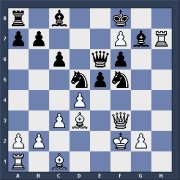 | |
| 21... | exd4?! |
| At last Black loses his way, perhaps dreaming of playing for a win? 21... Nd6! would lead to
equality according to Haugen, for after 22.Bg6 Black has two fair possibilities: (a) 22... Bd7 23.Bh6 Bxh6 24.Rh8+ Kg7 25.Rxa8 Kxg6 26.f8Q Bxf8 27.Rxf8 exd4 28.Re1 (28.Qg3+ Kf5) 28... Qf5 29.cxd4 Kg7 30.Rd8 Nf7 31.Qxf5 Bxf5 with a roughly level endgame, he believes. (b) 22... Nxf7 23.Bxf7 Qxf7 24.Bh6 Qg6 25.Bxg7+ Kg8 26.Rah1 Bg4= because after 27.Qg3 Black has perpetual check. | |
| 22.b3! | b5 |
| To stop the light-squared B having access to c4. | |
| 23.Qg4 | Nde7 |
| 24.Bf4 | |
| White wins the battle to control the e3 square and opens the way for his second R. The attack is reborn. | |
| 24... | Qxf7 |
| 25.Rah1 | Qg8 |
| Once more the long variations start to unwind in White's favour. An example given by Haugen
is 25... Qg6!? 26.Qf3 Be6 27.R1h5! Qe8 28.g4 Bf7 (28... Bg8 29.gxf5 Bxh7 30.Rxh7 Kg8 31.Rh4 dxc3 32.Bh6+-)
29.Rh8+ Ng8 30.Bxf5 Bxh5 31.Rxh5 and now: (a) 31... Ne7 32.g5 Qf7 33.g6 Qd5 34.Be4 Qe6 35.cxd4 Rd8 36.Be3 Kg8 37.Qh1 Kf8 (37... Nd5 38.Bd2) 38.Rh7 Nf5 39.Rxg7 Nxg7 40.d5+- (b) 31... dxc3 32.Bd6+ (32.Qxc3 is also possible) 32... Ne7 33.Be6 Qg6 (33... Qd8? 34.Qd3) 34.Qxc3 Qe4 35.Bf5 Qd5 36.Qb4 Re8 37.Bg6 Qe6 38.Bxe8 Kxe8 39.Bxe7 Qxe7 40.Qxe7+ Kxe7 41.Ke3 with a winning endgame for White. | |
| 26.Qh5 | Nd5 |
| Neither 26... dxc3 27.Bxf5 Nxf5 (or 27... Bxf5 28.Rxg7) 28.g4 Ne7 29.Rxg7 Qxg7 30.Bh6+-, nor 26... Qd5 27.c4 Qd7 28.cxb5 Ne3 (28... cxb5 29.g4+-) 29.Rxg7+- will do. Also, if 26... b4 27.Bxf5 Nxf5 28.g4 Qf7 29.Rh8+ Bxh8 30.Qxh8+ White wins. Finally, 26... Ne3 27.Bd6 Bd7 28.Bxe7+ (if 28.Qc5 Re8 29.Bg6 f5! 30.cxd4 N3d5 31.Bxe8 Kxe8 32.Bxe7 Nxe7 and Black is still in the game) 28... Kxe7 29.Re1+- intending simply cxd4 and Rxe3. Moving the K doesn't help: 29... Kf8 30.Qc5+, 29... Kd8 30.Qg6 Ng4+ 31.Kf1, or 29... Kd6 30.cxd4. Nor does 29... c5 30.Qxc5+ Kd8 31.Qxd4 Ng4+ 32.Kg1 followed by 33.Bf5+-, while if 29... Be8 30.Qc5+ Kd8 (if 30... Kf7 31.Bg6+! Kxg6 32.Qh5#) 31.Qxd4+ Nd5 32.Qg4 wins the g7B. | |
| 27.Bc1 | |
| Revealing another point of 22.b3: there can be a B check on a3. | |
| 27... | Qf7 |
| At last White could analyse to the final victory. If now 27... Nfe3 28.Ba3+ b4 29.Bxb4+ Nxb4 30.Qc5+ Ke8 (30... Kf7 31.cxb4+-) 31.Bg6+ Kd8 32.Qa5+ Kd7 33.Qxb4+- | |
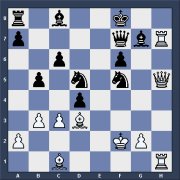 | |
| 28.Qh2!! | |
| White has a new invasion route: d6. | |
| 28... | dxc3 |
| Black also loses after 28... Qe6 29.g4, or 28... Nfe3 29.Ba3+ b4 30.Bxb4+ Nxb4 31.Qd6+ Qe7 32.Rh8+ Kf7 33.Bg6+, or 28... Qg8 29.g4 Nfe3 30.Ba3+ Ke8 31.Bg6+ Kd8 32.Qd6+ Bd7 33.Bf7 Qf8 34.Rh8.28... b4 was the move Haugen had expected, and he would have continued 29.cxb4 to be followed by Bxf5, Qd6+ etc, unless Black prefers to lose by 29... Nfe3 30.Rxg7 Qxg7 31.Qd6+ Ne7 32.Qd8+ Kf7 33.Rh7 or 29... Ke7 30.b5 c5 31.Ba3 | |
| 29.g4 | Qc7 |
| 30.Rh8+ | Kf7 |
| 31.Qh5+ | Ke7 |
| 32.Re8+ | Kd6 |
| 33.gxf5 | |
| Not 33.Bxf5? Kc5= (Haugen). Actually this is not a clear-cut draw, but the move he played is much stronger. The difference is that 33.gxf5 Kc5 34.Rg8 threatens 35.Qh7+- (or 35.Rg1), but after 33.Bxf5 Kc5 34.Rg8 Kb6 (say) 35.Qh7 fails to 35... Bxf5 (and Rg1 is obviously pointless). | |
| 33... | Kc5 |
| 34.Rg8! | Bb7 |
| 35.Rxa8 | 1-0 |
| Black resigned in view of 35... Bxa8 36.Qg4 Bf8 37.Rh8. | |